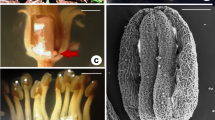Abstract
In the flowers ofApios americana the vexillum remains ± in its bud position. In this way, a dark cavity is formed displaying a bright window at its base. Insect visitors are attracted to the hidden inflorescences by scent. In their attempt to reach the window they trigger an explosive release of stigma and pollen. Stigmatic fluid glues pollen to the visitor. All characters of the flower fit well into the myiophilous syndrome and thus flies are expected to be the proper pollinators.Apios americana seems to be the only myiophilous exception within the predominantly melittophilousFabaceae.
Similar content being viewed by others
References
Adey, M. E., 1982: Plant-pollinator relationships in theGenistinae (familyLeguminosae). — Thesis, University of Southampton.
Bruneau, A., Anderson, G. J., 1988: Reproductive biology of diploid and triploidApios americana. — Amer. J. Bot.75: 1876–1883.
Delpino, F., 1968/1969: Ulteriori Osservazioni sulla dicogamia nel regno vegetale. Parte prima. — Atti Soc. Ital. Sci. nat.11/12.
Haupt, W., 1983: Heinz Paul 1908–1980. — Ber. Deutsch. Bot. Ges.96: 153–156.
Hildebrand, F., 1901: Einige biologische Beobachtungen. 4. Ueber die Blüthen vonApios tuberosa. — Ber. Deutsch. Bot. Ges.19: 479–483.
Loew, E., 1891: Ueber die Bestäubungseinrichtung und den Anatomischen Bau der Blüthe vonApios tuberosa Mch. — Flora49: 160–171, Tafel VI.
Nees von Esenbeck, C. G., Nees von Esenbeck, F., 1820: Elenchus Plantarum Horti Botanici Bonnensis. — Bonn.
Pijl, L. v. d., 1953: On the flower biology of some plants from Java, with general remarks on fly-traps. — Ann. Bogor.1: 77–99.
Seabrook, J. A. E., Dionne, L. A., 1976: Studies on the genusApios. I. Chromosome number and distribution ofApios americana andA. priceana. — Canad. J. Bot.54: 2567–2572.
Stubbendieck, J., Conard, E. C., 1989: Common legumes of the Great Plains. An illustrated guide. — Lincoln: University of Nebraska Press.
Taubert, P., 1893:Leguminosae. — InEngler, A., Prantl, K., (Eds): Die natürlichen PflanzenfamilienIII, 3, pp. 70–388. — Leipzig: Engelmann.
Troll, W., 1928: Organisation und Gestalt im Bereich der Blüte. — Berlin: Springer.
, 1951: Botanische Notizen II. 6. Diaphane Strukturen an Perianth- und Hochblättern. — Abh. Akad. Wiss. Lit. (Mainz) Math.-Nat. Kl. 1951 (2): 48–62.
, 1973: Allgemeine Botanik, 3rd edn. — Stuttgart: Encke.
Vogel, S., 1954: Blütenbiologische Typen als Elemente der Sippengliederung. Dargestellt anhand der Flora Südafrikas. — Bot. Studien1. — Jena: Fischer.
, 1961: Die Bestäubung der Kesselfallen-Blüten vonCeropegia. — Beitr. Biol. Pfl.36: 159–237.
, 1978: Evolutionary shifts from reward to deception in pollen flowers. — InRichards, A. J., (Ed.): The pollination of flowers by insects, pp. 89–96. — Linn. Soc. Symp. Ser.6. — London: Academic Press.
, 1984: Blütensekrete als akzessorischer Pollenkitt. — InEhrendorfer, F., (Ed.): Mitteilungsband Botanikertagung in Wien, 9.–14. September 1984, p. 123. — Wien: Institut für Botanik.
Waddle, R. M., Lersten, N. R., 1973: Morphology of discoid nectaries inLeguminosae, especially tribePhaseoleae (Papilionoideae). — Phytomorphology23: 152–161.
Westerkamp, C., 1993: The co-operation between the asymmetric flower ofLathyrus latifolius L. (Fabaceae: Vicieae) and its visitors. — Phyton33 (in press).
Author information
Authors and Affiliations
Additional information
Deceased 27. 12. 1980 at the age of 72 (Haupt 1983). In his assets, an unpublished manuscript (6 pp., 21 figs.) entitled “Bemerkungen über die Blüte vonApios tuberosa Mnch.” was found and passed on to the present author by Prof. DrW. Barthlott, Bonn
Rights and permissions
About this article
Cite this article
Westerkamp, C., Paul, H. Apios americana, a fly-pollinated papilionaceous flower?. Pl Syst Evol 187, 135–144 (1993). https://doi.org/10.1007/BF00994096
Received:
Revised:
Accepted:
Issue Date:
DOI: https://doi.org/10.1007/BF00994096




